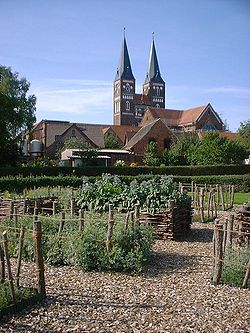
Jerichow
Encyclopedia
Jerichow (ˈjeːʁɪço) is a town in the Jerichower Land
district, in Saxony-Anhalt
, Germany
. It is situated on the right bank of the Elbe
, northwest of Genthin
.
Jerichow is home of Jerichow Abbey, the former Premonstratensian
convent
which was founded as early as 1144. In 1148 the construction of the convent church of St Mary and St Nicholas in a late romanesque
style started. This makes it one of the oldest remaining brick buildings in Northern Germany
and, through its artistic perfection, highly influential on the brick architecture in the Margraviate of Brandenburg
. The Abbey was shut down as such in the course of the Protestant Reformation
in the 16th century and the buildings have been used for various purposes since that time. Major repairs were made in the late 17th and the mid 19th century. The buildings were damaged by American artillery during the last days of World War II
and by a major fire in 1946. East Germany organized several rounds of provisional repairs in the 1950s and 1980s, but considerable war damage remained unfixed, and several buildings were near collapse in 1998, so that the Abbey had to be closed to the public. After this made the Abbey's problems obvious and put its continued existence in danger, a serious effort to repair the war damage materialized quickly and with much popular support. The buildings could be reopened to the public in 1999. They were fully restored in the following years and can be visited today.

Jerichower Land
Jerichower Land is a district in the north-east of Saxony-Anhalt, Germany. Neighboring districts are Anhalt-Bitterfeld, Salzlandkreis, the district-free city Magdeburg, Börde, Stendal, and the districts Havelland and Potsdam-Mittelmark in Brandenburg.- History :In 1816, the area of the district...
district, in Saxony-Anhalt
Saxony-Anhalt
Saxony-Anhalt is a landlocked state of Germany. Its capital is Magdeburg and it is surrounded by the German states of Lower Saxony, Brandenburg, Saxony, and Thuringia.Saxony-Anhalt covers an area of...
, Germany
Germany
Germany , officially the Federal Republic of Germany , is a federal parliamentary republic in Europe. The country consists of 16 states while the capital and largest city is Berlin. Germany covers an area of 357,021 km2 and has a largely temperate seasonal climate...
. It is situated on the right bank of the Elbe
Elbe
The Elbe is one of the major rivers of Central Europe. It rises in the Krkonoše Mountains of the northwestern Czech Republic before traversing much of Bohemia , then Germany and flowing into the North Sea at Cuxhaven, 110 km northwest of Hamburg...
, northwest of Genthin
Genthin
Genthin is a town in the Jerichower Land district, in Saxony-Anhalt, Germany. It is situated on the Elbe-Havel Canal, approx. 50 km northeast of Magdeburg, and 27 km west of Brandenburg....
.
Jerichow is home of Jerichow Abbey, the former Premonstratensian
Premonstratensian
The Order of Canons Regular of Prémontré, also known as the Premonstratensians, the Norbertines, or in Britain and Ireland as the White Canons , are a Catholic religious order of canons regular founded at Prémontré near Laon in 1120 by Saint Norbert, who later became Archbishop of Magdeburg...
convent
Convent
A convent is either a community of priests, religious brothers, religious sisters, or nuns, or the building used by the community, particularly in the Roman Catholic Church and in the Anglican Communion...
which was founded as early as 1144. In 1148 the construction of the convent church of St Mary and St Nicholas in a late romanesque
Brick Romanesque
Brick Romanesque is an architectural style and chronological phase of architectural history. The term described Romanesque buildings built of brick; like the subsequent Brick Gothic, it is geographically limited to Northern Germany and the Baltic region...
style started. This makes it one of the oldest remaining brick buildings in Northern Germany
Northern Germany
- Geography :The key terrain features of North Germany are the marshes along the coastline of the North Sea and Baltic Sea, and the geest and heaths inland. Also prominent are the low hills of the Baltic Uplands, the ground moraines, end moraines, sandur, glacial valleys, bogs, and Luch...
and, through its artistic perfection, highly influential on the brick architecture in the Margraviate of Brandenburg
Margraviate of Brandenburg
The Margraviate of Brandenburg was a major principality of the Holy Roman Empire from 1157 to 1806. Also known as the March of Brandenburg , it played a pivotal role in the history of Germany and Central Europe....
. The Abbey was shut down as such in the course of the Protestant Reformation
Protestant Reformation
The Protestant Reformation was a 16th-century split within Western Christianity initiated by Martin Luther, John Calvin and other early Protestants. The efforts of the self-described "reformers", who objected to the doctrines, rituals and ecclesiastical structure of the Roman Catholic Church, led...
in the 16th century and the buildings have been used for various purposes since that time. Major repairs were made in the late 17th and the mid 19th century. The buildings were damaged by American artillery during the last days of World War II
World War II
World War II, or the Second World War , was a global conflict lasting from 1939 to 1945, involving most of the world's nations—including all of the great powers—eventually forming two opposing military alliances: the Allies and the Axis...
and by a major fire in 1946. East Germany organized several rounds of provisional repairs in the 1950s and 1980s, but considerable war damage remained unfixed, and several buildings were near collapse in 1998, so that the Abbey had to be closed to the public. After this made the Abbey's problems obvious and put its continued existence in danger, a serious effort to repair the war damage materialized quickly and with much popular support. The buildings could be reopened to the public in 1999. They were fully restored in the following years and can be visited today.

External links
- Jerichow at the Romanesque Route (English/German)

